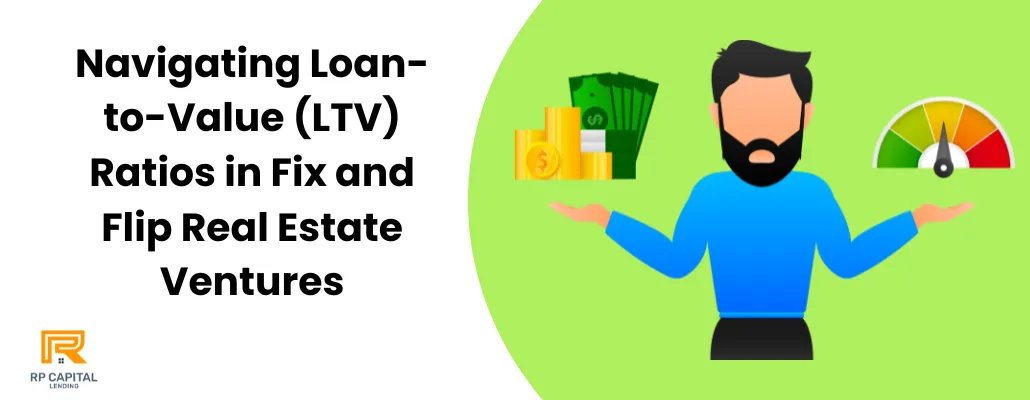Blog

Navigating Loan-to-Value (LTV) Ratios in Fix and Flip Real Estate Ventures
Imagine unlocking the door to a property that could potentially yield significant profits. Now, imagine having a tool that helps you assess the feasibility and potential return of this investment before you even buy it. That tool is the Loan-to-Value (LTV) ratio, an essential metric for anyone involved in fix and flip real estate ventures. Understanding LTV is like having a roadmap to your investment’s potential, guiding you to make informed decisions that balance risk and reward.
What is the Loan-to-Value (LTV) Ratio?
The Loan-to-Value (LTV) ratio is a critical financial term used by lenders to assess the risk of lending money for a real estate purchase. It is calculated by dividing the loan amount by the property's appraised value or purchase price, whichever is lower. This ratio is expressed as a percentage. A lower LTV indicates less risk for the lender, which can lead to more favorable loan terms for the borrower.
Why is the LTV Ratio Important in Fix and Flip Financing?
1. Determining Loan Amounts:
LTV is pivotal in determining how much a lender is willing to finance. In fix and flip projects, where the purchase and renovation costs must be carefully managed, understanding LTV can help investors secure the necessary funds to complete the project.
2. Influencing Interest Rates and Terms:
Generally, loans with lower LTV ratios have lower interest rates and better loan terms. This is because a lower LTV reduces the lender’s risk. Knowing this can lead to strategic financial planning and cost-saving on projects.
3. Impact on Approval Chances:
A favorable LTV ratio can significantly enhance the likelihood of loan approval. Lenders are more inclined to finance projects that present lower risk, which is indicated by a lower LTV.
4. Future Refinancing Opportunities:
A successful fix and flip project that positively alters the property’s value can improve the LTV ratio, potentially opening doors for refinancing at more advantageous terms.
Key Considerations for LTV Ratios in Fix and Flip Projects
Appraisal Values: Always ensure that the appraisal is accurate and reflective of the true market value of the property.
Market Trends: Understanding local real estate market trends can help predict potential increases in property values post-renovation.
Renovation Costs: Keep a precise and thorough accounting of all projected renovation costs to ensure the LTV remains within a manageable range.
Exit Strategy: Always have a clear plan regarding how to exit the investment, whether through sale or refinancing, and understand how the LTV will affect this process.
Frequently Asked Questions (FAQs)
Q1: What is an ideal LTV ratio for fix and flip financing?
While this can vary by lender, a lower LTV ratio of around 70% is often preferred for fix and flip projects, as it indicates substantial borrower investment and lower risk for the lender.
Q2: Can I improve the LTV ratio during a fix and flip project?
Yes, improvements and renovations that significantly increase the property value can improve the LTV ratio, enhancing refinancing options or making the property easier to sell.
Q3: What happens if the LTV ratio is too high?
A high LTV ratio can make it difficult to secure financing, may result in higher interest rates, and can increase the financial risk associated with the investment.
Q4: Are there ways to lower the LTV ratio before applying for a loan?
One effective strategy is to make a larger down payment, which directly reduces the loan amount, thereby lowering the LTV ratio.
Q5: How does the LTV ratio affect my exit strategy?
A favorable LTV ratio upon completion of renovations can allow for more profitable exit strategies, such as selling at a higher price or refinancing on better terms.
Conclusion
Understanding and managing the Loan-to-Value ratio is essential for anyone engaged in fix and flip real estate investments. It not only influences your ability to secure funding but also impacts your profitability and risk level throughout the project. By mastering LTV calculations and implications, investors can position themselves for success, ensuring each fix and flip project not only transforms a property but also turns a substantial profit.
RP Capital Lending is a d.b.a of RP Capital Partners Inc (NMLS # 2469193) | Privacy Policy
Copyright © 2022. All Rights Reserved.
Disclaimer: Loans only apply to non-owner occupied properties. Rates, terms and conditions offered only to qualified borrowers, may vary upon loan product, deal structure, other applicable considerations, and are subject to change at any time without notice.

